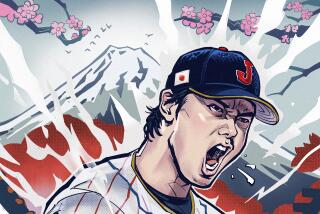Going bold and bright
- Share via
OUT of place in every way, Paul Jacoulet always seemed to be doing the right work at the wrong time. Born in France, he moved at age 3 to Tokyo in 1900. In the ‘30s, just as Imperial Japan entered its expansionist phase, Jacoulet came of age creatively by producing woodblock prints that revitalized the 17th century ukiyo-e tradition with blasts of hyper-vivid color. Postwar critics enthralled with Abstract Expressionism dismissed Jacoulet’s figurative pieces as “kitsch.” After the artist’s death in 1960, prints sold for $5 or $10.
But in recent years, Jacoulet has finally found a respectful audience. “Rainbow Colors: The Woodblock Prints of Paul Jacoulet,” presented at Pasadena’s Pacific Asia Museum through March 30, offers a 15-print travelogue depicting life in Japan, China, Korea and Micronesia. Exhibition curator Motoko Shimizu selected pieces from the museum’s complete collection of 166 Jacoulet prints that crossed boundaries both geographic and otherwise. “Some of Jacoulet’s works, such as ‘Parisian Lady’ or ‘Jade Lady,’ look like men in drag,” she says. “At a stretch they could be read as a self-portrait of the artist himself, who liked to wear kabuki-esque makeup and dress in elaborate kimono costumes.”
The mermaid portrait “The Mysterious Pacific,” inspired by a tour of South Pacific islands, epitomizes the artist’s perpetual sense of “otherness,” Shimizu says. “Neither fish nor human and of indeterminate race, she’s pensively looking off to the distance. People call it outlandish and over-the-top, but that piece is one of my favorites, and we chose it as the closing image.”
According to senior curator Ken Brown, Jacoulet brought a fresh eye to a classic art whose vitality had literally faded over the centuries. “Many of the famous ukiyo-e pieces collected in Europe and America in the late 1800s were faded, dirty copies of prints that had been around for hundreds of years,” he says. “That’s why Western artists would make prints using muted colors to evoke this soft, quiet vision of the past. Jacoulet realized this was a complete misunderstanding of the form.”
Working with master carvers and printers, Jacoulet embossed his work with expensive silver, gold and metallic pigments and routinely reprinted the same color block up to 10 times to produce deeply saturated colors. “That theatricality is what makes Jacoulet so exciting,” Brown says. “He saw the prints of the past not as some cheap popular art but as something that inspired in him these bold statements of fantasy and desire. He wasn’t afraid of anything.”
--
-- Hugh Hart
More to Read
The biggest entertainment stories
Get our big stories about Hollywood, film, television, music, arts, culture and more right in your inbox as soon as they publish.
You may occasionally receive promotional content from the Los Angeles Times.










